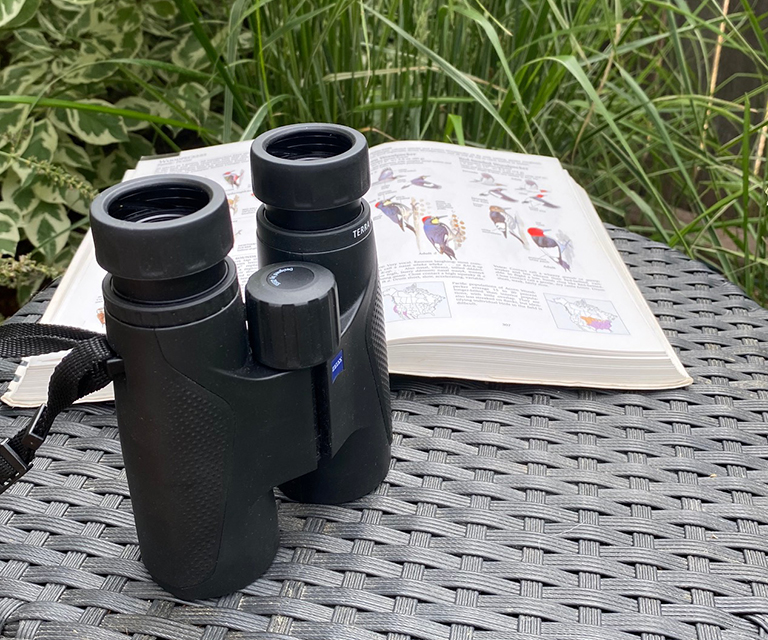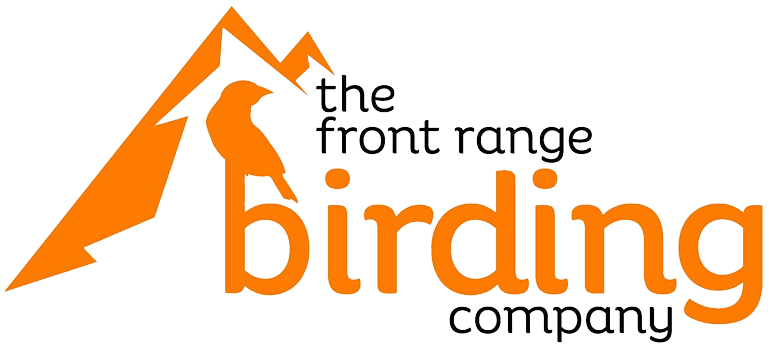So, what do those numbers mean?
Actually, it’s pretty simple. Take a pair of 8×42 binoculars. The first number (8x) is magnification i.e. how many times larger an object will appear. The second number (42) is the width of the big lens in front (the “objective lens”) in millimeters. The importance of both will become clear (pun totally intended), in the next two questions.
Is the width of the objective lens important?
Very! Think of it as the opening of a pipe. Now think of light as water. The bigger the objective lens, the more light it’s admitting and funneling to your eyes. It’s not a big deal on sunny days. But it matters in low light conditions, such as dawn and dusk, when birds are most active. That’s when you want as much light hitting your peepers as possible! Also, while full-size 8×42 and a travel-size 8×32 binoculars will provide the same magnification, the former will transmit more light to your eye because of the larger objective lens.
The Front Range Birding Company has a wide selection and you can ‘try before you buy’.

What’s the right magnification for birding? If 8x is good, isn’t 20x better?
Nope. Most birders use 8x magnification. Some use 10x. Almost no one goes beyond that. Here’s why. As magnification increases, your field of vision decreases. So 20x binoculars would make a bird appear larger, but that’s all you’d see. You’d never be able to track it in flight, let alone scan the environment around it. Plus, high magnification increases the effect of hand shudder. Since no one holds a pair of binoculars perfectly steady, the image of a bird viewed through 20x have constant nausea-inducing bounce.
What are coated lenses?
All quality binoculars (like those at FRBC) have, “fully multi-coated lenses.” That means they’ll have a high-tech, anti-reflective coating applied to the front and back of each binocular lens. It ensures as much light as possible makes it to your eyes. Naked glass reflects up to 5% of light away from your eye. Which means with cheapy binoculars containing uncoated lenses, you’re actually paying money for light to go in the wrong direction!
Does “waterproof” just mean binoculars are sealed shut against moisture?
No. Just making them impregnatable to water would still leave air inside. If you went from the comfy cool AC of your car to the hot environs of an outdoor birding trail, they’d actually fog up from the inside. And that’s bad. Quality binoculars are purged of air and filled with nitrogen gas, which contains zero moisture. So, they’ll never fog up from the inside. Guaranteed.
What’s “field of view?”
It’s the widest dimension that you can see from left to right through a stationary pair of binoculars. As a birder, it’s important to have a wide field of view to track fast moving birds on the wing and scan for wildlife. Look for a pair with a field of view that falls within the range of 290 – 470 ft @ 1,000 yards you won’t be disappointed.
Why do some binoculars cost so much more than others?
It’s all about quality. Good birding binoculars are precision optical instruments. And that takes precision components. Each binocular manufacture worth their salt spends a fortune on R&D to create specialized glass that captures almost every particle of light. They do the same with coatings that resist lens reflection. (Swarovski’s NL Pure 8×42 binoculars transmit an incredible 92% of available light to your eyes!) Plus, mechanical elements such as focus wheels need to be smooth and reliable yet stand up to the beating binoculars can take in the field. So, price increases with each of these elements along the good/ better/ best continuum. But so do the optical results.
Why do binoculars come in different shapes?
It’s because of the lens and prism alignment inside the binoculars. The traditional configuration that’s been around forever is called, “porro prism.” The newer, more streamlined design is called, “roof prism.” Both types provide the exact same optical experience. However, manufacturers are moving to the latter because they’re usually lighter and lest bulky.
What’s an “eye cup?”
It’s the key to a great optical experience! Each of the two binocular lenses you look through will have a “cup” that rotates in and out. It ensures your eyes are the proper distance from the lenses to receive the optimal amount of light (it’s called “eye relief.”) Here’s golden the rule: if you don’t wear classes, rotate the eye cups all the way out. If you do bird with glasses, keep them in. It’s simple…but critical!
How do I clean my binocular lenses?
A microfiber cloth with water or a small bottle of cleaning solution (like you use on eyeglasses) is all it takes. Do not use a sweaty t-shirt, gritty towel or home window cleaner. They’re scratch your lenses and dissolve the anti-reflective coatings that make your binoculars so special.
If you’re shopping for binoculars, The Front Range Birding Company carries both Boulder and the Denver metro’s largest selection of binoculars from optic leaders such as Zeiss, Diamondback, Swarovski and Opticron. Our product range is guaranteed to both greatly enhance your birding experience and fit your budget.
The Front Range Birding Company
Located in both Boulder and Littleton, Colorado, for more than 20 years independently owned FRBC has been the region’s go-to source for exceptional birding optics, guides, backyard bird feeders and fresh seed. Our pros will provide expertise during our “try-before-you-buy” binocular and spotting scope demo process so that you walk away with a product that’ll supply a lifetime of enjoyment.
Boulder
5360 Arapahoe Ave., Suite E.
Boulder CO, 80303
303.979.2475
boulder@frontrangebirding.com
Littleton
10146 West San Juan Way, Unit 110
Littleton, CO 80127
303.979.2473
littleton@frontrangebirding.com

